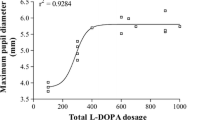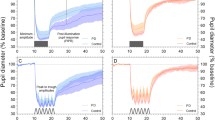Abstract
This study evaluated pupillary postganglionic autonomic dysfunction and its relationship to visual disturbance in idiopathic Parkinson’s disease (PD). Pupillary sensitivity was examined in relation to a parasympathomimetic agent [0.05% pilocarpine hydrochloride (PL)] and to a sympathomimetic agent [0.02% dipivefrine hydrochloride (DPE)] using infrared pupillography in 40 PD patients and 17 age-matched controls. Visual disturbances were evaluated as well, including blurring, photophobia, night blindness and involuntary eyelid closure in response to light. Pupillary supersensitivity to PL and DPE and their relation to visual disturbances were found to be significantly greater in PD patients than in controls (22.3 ± 15.1 vs. 10.4 ± 11.4%, P < 0.005, and14.5 ± 14.5 vs. 4.9 ± 8.7%, P < 0.01, respectively). In addition, pupillary sympathetic supersensitivity did not correlate with a reduction of 123I-metaiodobenzylguanidine (MIBG) cardiac accumulation. Patients with PD reported more blurred vision (P < 0.001) and involuntary eyelid closure in response to light (P < 0.05) than controls. Patients with supersensitivity to both PL and DPE complained more often of blurred vision than patients without supersensitivity (P < 0.05). Pupillary sensitivity to PL correlated significantly with a summed score for visual disturbance (P < 0.05, r = 0.417), but DPE sensitivity did not. PD patients have both parasympathetic and sympathetic postganglionic impairments affecting the pupil. Our findings demonstrate that parasympathetic dysfunction contributes significantly to visual disturbance in PD.



Similar content being viewed by others
References
Appenzeller O, Oribe E (1997) The pupil. In: Appenzeller O, Oribe E (ed) The autonomic nervous system. An introduction to basic and clinical concepts, 5th edn. Elsevier, Amsterdam, pp 443–466.
Braak H, Ghebremedhin E, Rub U, Bratzke H, Del Tredici K (2004) Stages in the development of Parkinson’s disease-related pathology. Cell Tissue Res 318:121–134.
Buehren T, Collins MJ (2006) Accommodation stimulus-response function and retinal image quality. Vision Res 46:1633–1645.
Cahill M, Eustace P, de Jesus V (2001) Pupillary autonomic denervation with increasing duration of diabetes mellitus. Br J Ophthalmol 85:1225–1230.
Daniel SE, Lees AJ (1993) The clinical features of Parkinson’s disease in 100 histologically proven cases. Adv Neurol 60:595–599.
Forno LS (1996) Neuropathology of Parkinson’s disease. J Neuropathol Exp Neurol 55:259–272.
Gottlob I, Strenn K, Schneider B (1994) Effect of levodopa on human dark adaption threshold. Grafes Arch Clin Exp Ophthalmol 232:584–588.
Granholm E, Morris S, Galasko D, Shults C, Rogers E, Vukov B (2003) Tropicamide effects on pupil size and pupillary light reflexes in Alzheimer’s and Parkinson’s disease. Int J Psychophysiol 47:95–115.
Hakusui S, Yasuda T, Yanagi T, Tohyama J, Hasegawa Y, Koike Y, Hirayama M, Takahashi A (1994) A radiological analysis of heart sympathetic functions with meta-[123I]iodobenzylguanidine in neurological patients with autonomic failure. J Auton Nerv Syst 49:81–84.
Hamada K, Hirayama M, Watanabe H, Kobayashi R, Ito H, Ieda T, Koike Y, Sobue G (2003) Onset age and severity of motor impairment are associated with reduction of myocardial 123I-MIBG uptake in Parkinson’s disease. J Neurol Neurosurg Psychiatry 74:423–426.
Hunter S (1985) The rostral mesencephalon in Parkinson’s disease and Alzheimer’s disease. Acta Neuropathol 68:53–58.
Jellinger KA (1999) Post mortem studies in Parkinson’s disease—is it possible to detect brain areas for specific symptoms? J Neural Transm Suppl 56:1–29.
Kesler A, Korczyn A (2006) Visual disturbances in Parkinson’s disease. Pract Neurol 6:28–33.
Korczyn AD (1990) Autonomic nervous system disturbances in Parkinson’s disease. Adv Neurol 53:463–468.
Matthews MR (1999) Autonomic ganglia and preganglionic neurones in autonomic failure. In: Bannister R, Mathias CJ (eds) Autonomic failure. A textbook of clinical disorders of the autonomic nervous system, 4th edn. Oxford University Press, pp 329–339.
Micieli G, Tassorelli C, Martignoni E, Pacchetti C, Bruggi P, Magri M, Nappi G (1991) Disordered pupil reactivity in Parkinson’s disease. Clin Auton Res 1:55–58.
Micieli G, Tosi P, Marcheselli S, Cavallini A (2003) Autonomic dysfunction in Parkinson’s disease. Neurol Sci 24 (suppl 1):S32–S34.
Niimi Y, Ieda T, Hirayama M, Koike Y, Sobue G, Hasegawa Y, Takahashi A (1999) Clinical and physiologic characteristics of autonomic failure with Parkinson’s disease. Clin Auton Res 9:139–144.
Orimo S, Oka T, Miura H, Tsuchiya K, Mori F, Wakabayashi K, Nagao T, Yokochi M (2002) Sympathetic cardiac denervation in Parkinson’s disease and pure autonomic failure but not in multiple system atrophy. J Neurol Neurosurg Psychiatry 73:776–777.
Sawada H, Yamakawa K, Yamakado H, Hosokawa R, Ohba M, Miyamoto K, Kawamura T, Shimohama S (2005) Cocaine and phenylephrine eye drop test for Parkinson disease. JAMA 293:932–934.
Schlossmacher MG, Frosch MP, Gai WP, Medina M, Sharma N, Forno L, Ochiishi T, Shimura H, Sharon R, Hattori N, Langston JW, Mizuno Y, Hyman BT, Selkoe DJ, Kosik KS (2002) Parkin localizes to the Lewy bodies of Parkinson disease and dementia with Lewy bodies. Am J Pathol 160:1655–1667.
Smith SA, Smith SE (1999) Investigation of autonomic disorders. In: Bannister R, Mathias CJ (eds) Autonomic failure. A textbook of clinical disorders of the autonomic nervous system, 4th edn. Oxford University Press, pp 245–253.
Sugiyama T, Utsumi T (1990) Pupillary dynamics in Parkinson’s disease. Neuroophthalmology 10:1–7.
Takeda S, Yamazaki K, Miyakawa T, Arai H (1993) Parkinson’s disease with involvement of the parasympathetic ganglia. Acta Neuropathol 86:397–398.
Tamer C, Melek IM, Duman T, Oksuz H (2005) Tear film tests in Parkinson’s disease patients. Ophthalmology 112:1795.
Utsumi T (2000) Pharmacological eye drop test. In: Japan Society of Neurovegetative Research (ed) Autonomic function test, 3rd edn. Bunkodo, pp 272–275.
Walshe, Hoyt W (1984) The Pupil: Embryology, anatomy, innervation and normal function. In: Miller (ed) Clinical neuro-ophthalmology, 4th edn. Williams & Wilkins, Baltimore, pp 400–441.
Author information
Authors and Affiliations
Corresponding author
Appendix
Appendix
Visual subjective disturbance scale in this study
Please read the following questions and try to answer on the basis of how you feel in daily life.
-
A.
Blurred vision: during the day, how often do you feel blurred vision?
-
0
Never
-
1
Sometimes, but it does not bother me
-
2
Often, so I have trouble seeing
-
3
Always
-
0
-
B.
Photophobia: how much do you feel photophobia?
-
0
Never
-
1
Sometimes, but it does not bother me
-
2
Often, so I have trouble seeing
-
3
Always
-
0
-
C.
Night blindness: in darkness, do you have no trouble seeing?
-
0
No, I have any trouble seeing
-
1
Yes, I sometimes have trouble seeing in darkness, but it does not bother me
-
2
Yes, I often have trouble seeing in darkness
-
3
Yes, I cannot seeing in darkness
-
0
-
D.
Involuntary eyelid closure in response to light: how often do you have involuntary eyelid closure in response to light?
-
0
Never
-
1
Sometimes, but it does not bother me
-
2
Often, so I have difficulty in some of daily performance
-
3
Always, so I have difficulty in almost all of daily performance
-
0
Rights and permissions
About this article
Cite this article
Hori, N., Takamori, M., Hirayama, M. et al. Pupillary supersensitivity and visual disturbance in Parkinson’s disease. Clin Auton Res 18, 20–27 (2008). https://doi.org/10.1007/s10286-008-0453-4
Received:
Accepted:
Published:
Issue Date:
DOI: https://doi.org/10.1007/s10286-008-0453-4




